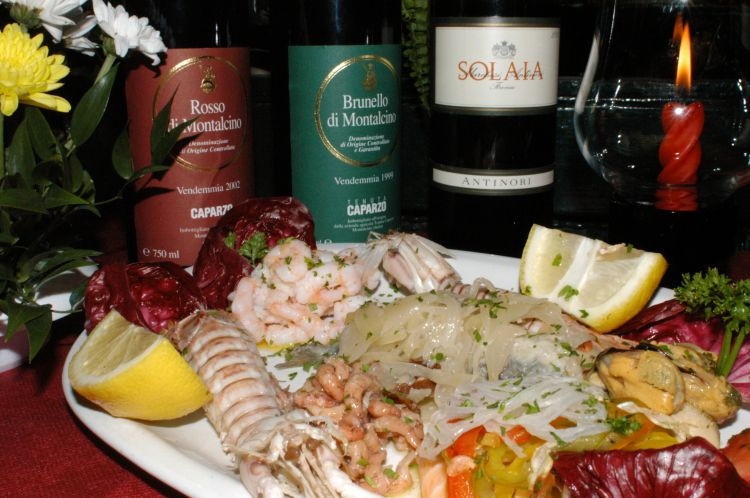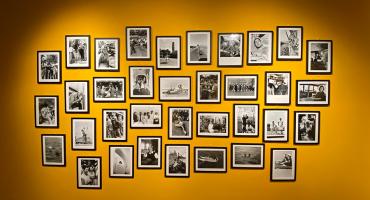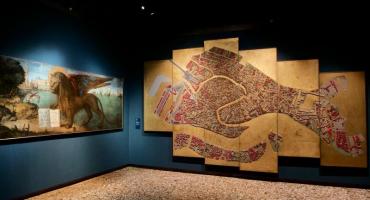A city like Venice, that has always maintained contacts both with the inland and with diverse and faraway countries, presents in its culinary tradition a variety of dishes linked to the different origins of ingredients.
Well, this is why we see on our tables baccalà (dried salted cod) from the
Baltic routs, precious spices from the caravans of Asia but also fresh
vegetables from islands of the estuary, fish from the lagoon and game
shot in sandbanks. Already around 1000, Venice spread to all the regions
food customs and habits of the nations that it had good business relationships
with. So this is the reason why, even today, use of spices is the fundamental
characteristic of the Veneto cuisine, which unifies multiplicity of the
gastronomic traditions linked to the territory. Venetian cuisine, made with poor
ingredients, becomes nothing short of refined with use of spices.
Traditional grains which have
been in use since Roman times, like wheat, rye, spelt, oats, barley, millet got
placed side by side or replaced with American corn or potatoes. Initially,
corn was welcomed and cultivated only on the territory of Schio but then it
spreads out and the era of polenta begins like this in Veneto. Other new
foods which get inserted bringing innovation of the cuisine are tomatoes,
beans, peppers, aubergines and turkey meat.
Rise gets also presented and becomes
necessary for Veneto dishes. Having arrived from Arabic world, quite soon it
became a key ingredient of Venetian cuisine. The most famous of the Venetian
soups is risi e bisi (rice and peas), which the doge
was obliged to eat on the St Mark’s day following a precise ritual. Amongst the
characteristic first courses, there is pasta e fasioi (pasta and beans),
a very diffused peasant dish and very much appreciated in Venice.
In contrast to the popular idea of
Italians as eaters of pasta and spaghetti, in Venice, the only traditional
pasta are bigoli (thick and coarse spaghetti), whose
preparation was traditionally entrusted with men, given the hardness of dough.
Amongst the most typical and worldwide
known main courses, there is the famous fegato alla veneziana (Venetian
style liver). The Romans used to
cook it with figs to sweeten up the bitterish aftertaste of meat, but the Venetians have adopted the cooking with
onions.
Another important meat dish is duck, served
on the basis of different recipes, like for example stuffed duck of duck breast
in sweet & sour. Obviously, Venice, being a city on the water, has always
made use of all its fish resources with fantasy, making what it wanted with
courses of fish of all types.
An important and well-known element of
Venetian cuisine is baccalà Mantecato (creamed cod)
introduced by Pietro Querini who imported it from the Lofoten islands. Next to
dried cod, another one of the most ancient Venetian recipes (a speciality from
Murano, to be precise) is bisato su l'ara (eel roasted with bay
leaves). Traditionally, roasting was done in glass furnaces, in the evening
after work. But the other typical dishes can not be disregarded, such as seppie
col nero (cuttlefish in their ink), sardelle in soar (sardines
in onion marinade) and caparossoli in cassopipa (clams with
parsley).
In Venice, daily fished fish and seafood reach local markets
early in the morning. It’s not a surprise then that fish is the basis of
Venetian cuisine. In fact, what might surprise is that, despite the
variety and quality of the catch, the Venetians have adopted enthusiastically dried
cod for which there have been many recipes, especially in convents. This
is because the strict rules of the Council of Trent, which imposed to abstain
from using meat in certain times of the year, and difficulty of finding always
fresh fish in the region, made this fish a very popular food alternative
Next to main courses, vegetable side
dishes like the famous fondi di carciofo (artichokes ends), fasioi
in salsa (beans in sauce) or radicchio alla trevigiana (Trevisian
style chicory) revive the Venetian table in a harmony of colours and
flavours. Venetian cuisine is disclosed as a culinary art open to innovations
of Central Europe, sensitive to refined French habits, that arrived to Veneto
through foreign chefs employed by many noble Venetian families. Let’s remind
you of the example of introduction of sugar, a main ingredient of Veneto
cakes of that time, as a substitute for age-old honey, olive oil and butter,
instead of lard, bacon and goose fat. But beside tradition, in the
present-day daily routines, the most diffused and appreciated by all meal is Venetian
sandwich. Two slices of bread without crust, that contain anything filled
with mayonnaise: eggs, tuna, tomatoes, mozzarella, fresh vegetables, raw ham,
olives, artichokes… an absolute expression of creativity which unbelievably
fills up these food breaks, taken in massive doses by all Venetians and
combined often and voluntarily with a glass of spritz, a Venetian local aperitif. These two elements have
by now become expression of 'Venetian way of life'.

Some Venetian recipes...
Risi e bisi
(Rice and peas)
Bigoli con l’Anatra (Pasta with
duckmeat)
Pasta e
fagioli (pasta and beans)
Anatra
ripiena (Stuffed duck)
Baccalà
mantecato (Creamed cod)
Fegato
alla veneziana (Venetian style liver)
Petto
d'anatra in agrodolce (Duck breast in sweet & sour)
Seppie col
nero (Cuttlefish in their ink)
Fagioli in salsa (Beans in sauce)
Fondi di
carciofo (Artichokes ends)
Patate
alla veneziana (Venetian style potatoes)
Radicchio
alla trevigiana (Trevisian style chicory)
Baicoli
veneziani (Venetian biscuits)
Crema fritta
(Fried cream)
Frittelle
di zucca (Pumpkin doughnuts)
Torta
Nicolotta (Nicolotta cake)
Torta
Sabbiosa (Sandy cake)



